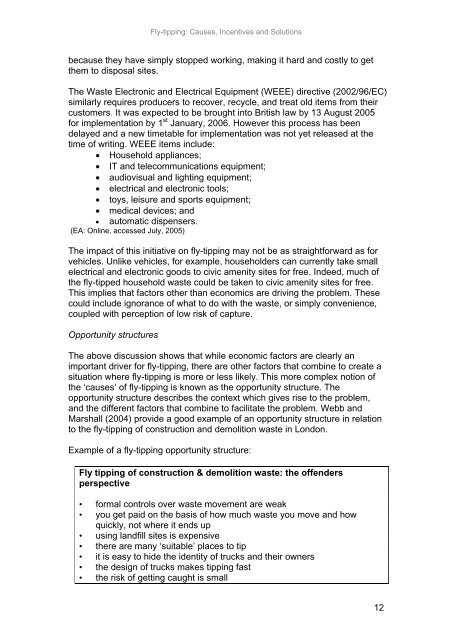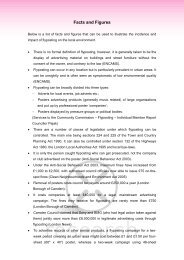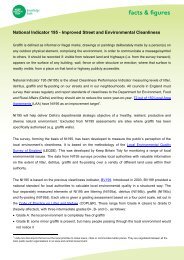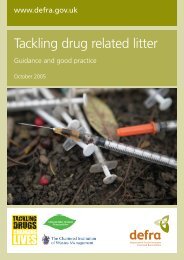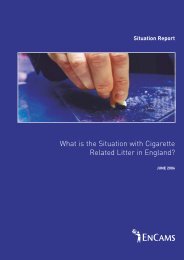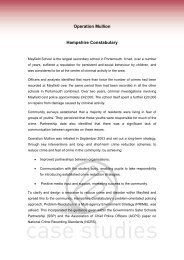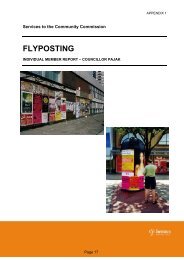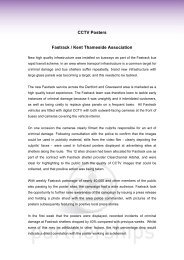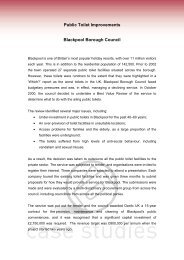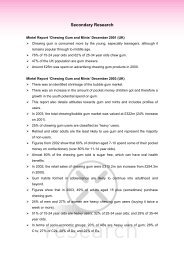Fly-tipping: Causes, Incentives and Solutions - Keep Britain Tidy
Fly-tipping: Causes, Incentives and Solutions - Keep Britain Tidy
Fly-tipping: Causes, Incentives and Solutions - Keep Britain Tidy
You also want an ePaper? Increase the reach of your titles
YUMPU automatically turns print PDFs into web optimized ePapers that Google loves.
<strong>Fly</strong>-<strong>tipping</strong>: <strong>Causes</strong>, <strong>Incentives</strong> <strong>and</strong> <strong>Solutions</strong><br />
because they have simply stopped working, making it hard <strong>and</strong> costly to get<br />
them to disposal sites.<br />
The Waste Electronic <strong>and</strong> Electrical Equipment (WEEE) directive (2002/96/EC)<br />
similarly requires producers to recover, recycle, <strong>and</strong> treat old items from their<br />
customers. It was expected to be brought into British law by 13 August 2005<br />
for implementation by 1 st January, 2006. However this process has been<br />
delayed <strong>and</strong> a new timetable for implementation was not yet released at the<br />
time of writing. WEEE items include:<br />
• Household appliances;<br />
• IT <strong>and</strong> telecommunications equipment;<br />
• audiovisual <strong>and</strong> lighting equipment;<br />
• electrical <strong>and</strong> electronic tools;<br />
• toys, leisure <strong>and</strong> sports equipment;<br />
• medical devices; <strong>and</strong><br />
• automatic dispensers.<br />
(EA: Online, accessed July, 2005)<br />
The impact of this initiative on fly-<strong>tipping</strong> may not be as straightforward as for<br />
vehicles. Unlike vehicles, for example, householders can currently take small<br />
electrical <strong>and</strong> electronic goods to civic amenity sites for free. Indeed, much of<br />
the fly-tipped household waste could be taken to civic amenity sites for free.<br />
This implies that factors other than economics are driving the problem. These<br />
could include ignorance of what to do with the waste, or simply convenience,<br />
coupled with perception of low risk of capture.<br />
Opportunity structures<br />
The above discussion shows that while economic factors are clearly an<br />
important driver for fly-<strong>tipping</strong>, there are other factors that combine to create a<br />
situation where fly-<strong>tipping</strong> is more or less likely. This more complex notion of<br />
the ‘causes’ of fly-<strong>tipping</strong> is known as the opportunity structure. The<br />
opportunity structure describes the context which gives rise to the problem,<br />
<strong>and</strong> the different factors that combine to facilitate the problem. Webb <strong>and</strong><br />
Marshall (2004) provide a good example of an opportunity structure in relation<br />
to the fly-<strong>tipping</strong> of construction <strong>and</strong> demolition waste in London.<br />
Example of a fly-<strong>tipping</strong> opportunity structure:<br />
<strong>Fly</strong> <strong>tipping</strong> of construction & demolition waste: the offenders<br />
perspective<br />
• formal controls over waste movement are weak<br />
• you get paid on the basis of how much waste you move <strong>and</strong> how<br />
quickly, not where it ends up<br />
• using l<strong>and</strong>fill sites is expensive<br />
• there are many ‘suitable’ places to tip<br />
• it is easy to hide the identity of trucks <strong>and</strong> their owners<br />
• the design of trucks makes <strong>tipping</strong> fast<br />
• the risk of getting caught is small<br />
12


